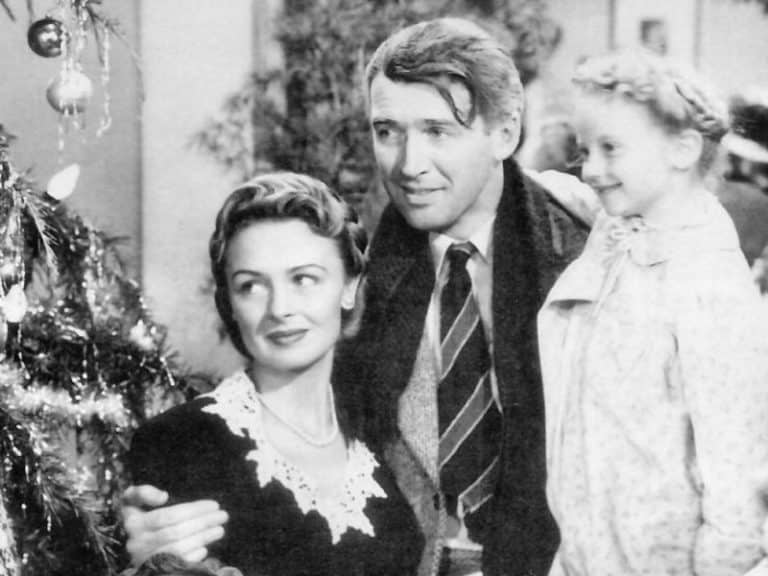Guest Post by Anelise Leishman. Anelise is a BYU English grad and an avid writer, podcast listener, and general consumer of media. You can find more of her work at aneliseleishman.com.
Each year on Christmas Eve, my family watches Frank Capra’s “It’s a Wonderful Life.” And each year—especially now, as I begin to settle into adulthood—it holds more and more meaning for me.
For the uninitiated, “It’s a Wonderful Life” walks us through the life of George Bailey: a man who, despite his ambitions to travel the world, spends his whole life in his hometown of Bedford Falls running the Building & Loan company his father left behind. He struggles to keep the business afloat and prevent the villainous Mr. Potter from taking over the entire town. At the end of his rope one Christmas Eve, George is given the “rare gift” of seeing what the world would be like if he had never been born. Without his influence, George sees his little world of Bedford Falls in a bizarre, fallen state, the people closest to him destitute and alone in “Pottersville.” He realizes how much his life—one that before he saw as wasted in a “shabby little office”—is really worth.
Frank Capra’s Catholic faith figures heavily into his storytelling. One of the biggest clues is the name of Mr. Potter’s housing project: Potter’s Field. This presumably takes its name from the New Testament, from the “field of blood” that the chief priests purchase with Judas’s tainted silver pieces after his suicide: “And they took counsel, and bought with them the potter’s field, to bury strangers in” (Matt. 27:7). With this in mind, George Bailey emerges easily as the film’s savior figure. Without the Building & Loan and George’s kindness, the town is condemned to poverty and depravity in the potter’s field—death without salvation.
In George’s life, we see Christ’s humanity, His desperation—and, interestingly, a different type of sacrifice than we usually associate with the Savior. George spends his entire life yearning for a sense of purpose, wanting to do “something big, something important,” but his dreams of adventure are constantly thwarted by duty: instead, he carries out a life of service and sacrifice to continue his father’s legacy. It was never about what he wanted—“not my will, but thine, be done.” He sacrifices his youth, his desires, and his personal wealth to fight on the side of righteousness in the struggle for good and evil in Bedford Falls. He even undergoes his own temptation: “You wouldn’t mind living in the nicest house in town, buying your wife a lot of fine clothes, a couple of business trips to New York a year, maybe once in a while Europe? You wouldn’t mind that, would you George?”
Ultimately, the movie’s conflict centers around a debt that has to be paid. In the end, George is able to pay it with the help of his friends. His kind deeds and many sacrifices over the years are repaid to him tenfold, and we see that his sleepy life in Bedford Falls is bigger and more important than any lofty adventures he might have had otherwise. One by one, we see all the people who George has saved, and the impact that one man’s life—and even his death—can have in his own little universe.
Each year I watch this movie one year older, as my grasp on what “faith” is becomes more complicated, often tied up in dogma and politics. But I find that this film grounds me in what a life of service looks like. It remains to me one of the strongest and most tangible allegories of Christlike love and sacrifice, and what it means to touch as many lives as possible for the better.




4 Responses
Great post! I hadn’t made that connection before, of seeing the main character as a savior figure. Last year I watched a movie based on “It’s a Wonderful Life”, which is called “It Happened One Christmas.” It’s the same story but with a woman as the main character. These movies definitely help remind us to serve others and to remember all the good that comes from our service to others, and that it has a greater effect than we realize.
Thank you Dani! And thank you for the recommendation – I will have to check that one out. I think it’s rare we get Christmas movies with female protagonists…
I am embarrassed that I never noticed the scriptural name “Potter’s Field.” Thanks for this review. I just saved this movie to my watchlist to share it with my kids, and it will be much more meaningful after reading this.
Thank you so much, April. I kept noticing new connections when I watched this time around. I have a feeling that’ll happen every year from now on.